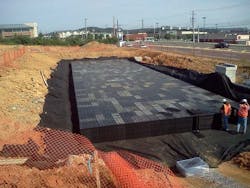Thinking Outside the Big Box
Once a sprawling 636-acre farm, the Spring Ridge Corporate Center is now a bastion of growth in the rural landscape of Berks County, Pa.
More than 20 years ago, a rapidly expanding bank began to change a seemingly picturesque location into a commercial hub. What started as a four-story, 372,000-sq-ft headquarters has become a corporate center with eight buildings and more than 500,000 sq ft of corporate office space.This spurred rapid growth of commercial and residential development around the property, bringing a new shopping center, hotel, additional office buildings and even a medical center to the surrounding landscape. With the beautiful, flowing farmland nearly gone and a community looking to preserve its remaining open space, developers had to get creative.
For years, corporations—trying to cash in on the last remaining parcel—fought to build the last shopping center of a once farm-friendly community. Each time, the community raised its collective voice and rallied to maintain the remaining undeveloped land. Then came Kohl’s Department Store, which had an idea: Construct a store on the last remaining commercial outparcel of an already-built complex. There was one problem; as the complex had grown and the designs had gotten away from the original plans, the last planned parcel had become a detention basin to collect the construction site’s runoff.
This was another bump in the road, but the developers had a client who knew what they wanted and had a timeline for opening in mind. When the Kohl’s store was announced, no one on the outside knew the mammoth undertaking going on behind the scenes. McCarthy Eng. of Reading, Pa., was tasked with developing a plan to build a big-box store on a parcel originally laid out for two small restaurants, as well as mitigate runoff from the existing corporate center—in addition to the Kohl’s site.
With a timeline of less than two years, the daunting task of getting regulatory approvals and a building constructed began. The designers sketched out a standard retail lot, with parking, a store and landscaping, and before they knew it, they had utilized the entire property. With NPDES requirements still to be met and the municipality wanting to make sure everything was taken care of, the engineers came up with an idea: incorporating aboveground storm water facilities with underground detention.
The design began by directing a portion of the runoff from the existing site to a neighboring basin that was overly large for its drainage area. With this reduced existing requirement and a new site remaining, the team began to look for a product that would provide the necessary storage, but not exceed the project’s budget. A local corporation with more than 30 years in the water and wastewater industry had a solution: Brentwood Industries’ StormTank, a lightweight, polymeric, subsurface storm water storage structure with the largest void space on the market. The designers utilized the product to mitigate the remaining runoff that the aboveground bio-filtration and basins could not handle with the tight dimensional constraints.
To meet the regulatory requirements for volume and rate, two subsurface detention basins were incorporated into the design. Combined, these basins provided slightly less than 19,000 cf of storm water storage while impacting zero buildable land. In fact, both basins were able to be located under the parking facilities, as the products are designed to support an HS-25 load. In addition, the product’s design allowed for the easy incorporation of an impermeable liner to prevent infiltration in this heavy hotspot of Karst geography and sinkholes.
With the final touches in place and regulatory approval in hand, this development has a new resident. Successfully installed under the parking lot of the Kohl’s Department Store in August of 2012, the StormTank system permitted the necessary mitigation to meet regulatory needs while expanding usable land and providing the necessary cleanability—and the design met the needs of the designer, owner, community and regulatory agencies.
Jason Bailey, E.I.T, is product manager for Brentwood Industries. Bailey can be reached at [email protected] or 484.824.2324.


